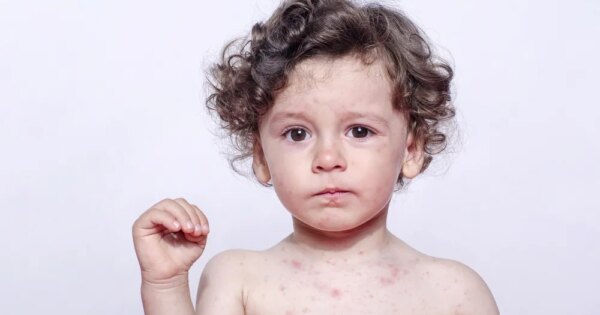Rashes in children are a common occurrence. They represent a reaction and consist of a noticeable change in the texture or color of the skin. Symptoms may include redness, scaling, itching, pimples, bumps, hives, or cysts. Determining the cause of a rash in children can be challenging. Common causes of rashes in children include infections (viral, bacterial, or fungal) and allergies. Most childhood rashes are benign (harmless) and go away on their own. However, some rashes in children are serious or even life threatening. As a result, parents concerned over rashes in their children should seek the advice of a physician.
To give you a bit of insight, we have listed here the most common 12 skin rashes you’ll find in your child.
12. Measles
Measles, also known as rubeola, is a highly contagious viral illness. It is primarily a childhood illness, but may affect people of all ages. Measles is caused by the measles virus, which is classified as a Morbilivirus. It is spread through direct contact with discharge from the nose or throat and via air-borne droplets from an infected individual. Measles can be prevented with the measles vaccine, which is given in combination with the mumps and rubella vaccine (MMR).
The most common symptoms of measles are rash, fever, and cough. A deep, red, flat rash starting on the face and spreading out to the trunk, arms, and legs characterizes measles. The rash starts out as small, distinct lesions that eventually coalesce, or come together, to form one large rash. Treatment of measles is symptomatic and consists of increased fluid intake and acetaminophen for fever. Aspirin should not be given to children due the risk of Reye’s syndrome. Complications of measles may include ear infection, pneumonia, bronchitis, and a low platelet count.
11. Rubella
Rubella, also known as German measles, is a childhood viral illness that causes a skin rash. It is caused by the rubivirus. Rubella is spread through direct contact with discharge from the nose or throat of an infected individual. It can be prevented with the rubella vaccine, which is given in combination with the mumps and measles vaccine (MMR). Rubella is a much milder infection than measles (rubeola).
The rash of rubella is characterized as fine and pink and begins on the face before spreading to the trunk, arms, and legs. Accompanying symptoms of measles may be fever, headache, nasal congestion, and enlarged, tender lymph nodes. There is no cure for rubella infection and treatment rest, increased fluid intake, and acetaminophen for fever/aches. Children with rubella should not come into contact with pregnant due to the risk of congenital rubella, which can have complications such as cataracts, mental retardation, enlarged liver and spleen, and bleeding problems.
10. Chickenpox
Chickenpox, also known as varicella, is a high contagious viral childhood illness. It is caused by the varicella-zoster virus, a form of the herpes virus. Transmission of the disease occurs through direct person-to-person contact or via air-borne droplets. Chickenpox most commonly is diagnosed in children aged 5 to 9-years. Since the development of the chickenpox vaccine in 1995, the disease has declined significantly in the United States.
Typical symptoms of chickenpox include rash, fatigue, and low-grade fever. The rash of chickenpox has three characteristic phases: raised red bumps (papules) that transform into fluid-filled blisters (vesicles), which finally rupture and are replaced by scabs. It is not uncommon to see all three phases of the rash as the same time in the same individual. Since chickenpox is a viral disease, there is no cure for infection. Chickenpox is normally a mild disease, but may be complicated by pneumonia, secondary bacterial infections, poor muscular coordination, and encephalitis (inflammation of the brain).
9. Roseola
Roseola, or sixth disease, is a contagious viral illness that occurs among children. The most common cause of roseola is human herpes virus 6 (HHV-6). The hallmark symptoms of roseola are high fever and rash. The rash consists of small, pink, flat or slightly raised lesions that appear initially on the torso and spread to the face, arms, and legs. Overall, the illness is not serious and most children fully recover within a week.
Roseola most commonly affects children under the age of 2 and can occur at any time of the year. Over-the-counter medications such as acetaminophen (Tylenol) or ibuprofen (Advil, Motrin) may be given to reduce fever, which could reach as high as 103.5-degrees Fahrenheit. Aspirin should be avoided in children due to the risk of Reye’s syndrome, which can be fatal. Occasionally, the high fever accompanying roseola may cause seizures (febrile seizures), which are short-lived and rarely harmful.
8. Erythema Infectiosum
Erythema infectiosum, or fifth disease, is a contagious viral illness that can develop at any age, but occurs primarily among children aged 5 to 15-years. The illness is caused by infection with human parvovirus B19. The majority of individuals infected with parvovirus have no symptoms, but approximately 25-percent will develop fifth disease. Erythema infectiosum can occur year round, but occurs most commonly in winter and early spring.
Erythema infectiosum is characterized by the development of a bright red, slightly raised rash on the cheeks, which gives the appearance of slapped cheeks. Over several days, the rash on the cheeks fades and is replaced by a lacy red rash spreading to the torso and extremities. In children, the illness is benign (harmless) and resolves without complications. Treatment is symptomatic and may include rest, plenty of fluids, and acetaminophen (Tylenol) or ibuprofen (Advil, Motrin) as needed. Aspirin should be avoided in children.
7. Hand-Foot-and-Mouth Disease
Hand-foot-and-mouth disease (HFMD) is a viral illness commonly seen in children. The majority of cases of the disease are caused by coxsackievirus A type 16. The rash of HFMD consists of tender blisters in the mouth, tongue, and/or hard palate. The lesions may also be found on the palms and soles of the hands and feet, buttocks, or genitalia. Epidemics of HFMD generally occur in the summer to early fall and most commonly affect children younger than 10-years.
The incubation period for hand-foot-and-mouth disease is 1-week. Symptoms (in addition to rash) may include sore mouth or throat, fever, decreased appetite, malaise (a general feeling of discomfort), and rarely vomiting. There is no cure for the disease and treatment is supportive. The most common complication of HFMD is dehydration, which is due to painful blisters erupting in the mouth and tongue. Serious complications are rare. Most cases of HFMD run their course in 7 to 10-days.
6. Molluscum Contagiosum
Molluscum contagiosum is a highly contagious viral skin infection that commonly affects children. The disease is caused by a poxvirus. The virus is transmitted through direct skin-to-skin contact or indirectly through contact with contaminated objects. Molluscum contagiosum most commonly affects children 1 to 5-years of age. Scratching lesions spreads the virus to nearby skin, which is termed autoinoculation. Without treatment, the disease usually resolves within 12-months. Removal under the supervision of a physician is also an option.
The rash of molluscum contagiosum consists of multiple small nontender, dome-shaped, flesh-colored papules (solid raised bumps) with a central umbilication (depression). The lesions range is size from 2 to 5-millimeters. The characteristic papules may be located anywhere, but are most commonly observed on the face, trunk, and extremities. Besides the rash, children infected with molluscum contagiosum are asymptomatic and usually do not have systemic symptoms such as fever, nausea, or malaise.
5. Scarlet Fever
Scarlet fever represents a bacterial infection and can best be described as strep throat with a characteristic rash. The infection is caused by group A beta-hemolytic streptococci (GABHS). Toxins produced by GABHS are responsible for the rash of scarlet fever. The disease may occur year round, but predominantly affects school-aged children during the winter and spring. GABHS is contagious and spread from person-to-person via coughing or sneezing. Spread of GABHS may be decreased through hand washing.
Initial symptoms of scarlet fever include sore throat, fever, headache, upset stomach, and swollen glands in the neck. After 1 to 2-days, a distinctive red rash develops which is described as feeling like sandpaper and looking like sunburn. The rash itself is not serious or contagious, but the underlying strep bacterial infection may cause serious complications if left untreated. Scarlet fever requires treatment with a course of antibiotics prescribed by a physician.
4. Impetigo
Impetigo is a highly contagious bacterial infection of the superficial layers of the skin. It is the most common bacterial skin infection in children. Impetigo is primarily caused by streptococcal (strep) or staphylococcal (staph) bacteria. The infection can occur anywhere on the body, but most commonly occurs around the nose and mouth. Impetigo can be categorized as bullous (blistering) or nonbullous. Nonbullous impetigo is the most commonly occurring category. Bullous impetigo is less contagious than the nonbullous form.
Impetigo manifests as a red vesicular (fluid-filled blisters) or pustular (pus-filled blisters) rash. The lesions are small (< 2-cm) and subsequently rupture leaving behind a lesion with honey-colored crusting. A skin condition such as minor trauma, insect bites, scabies, poison ivy, or eczema usually predates impetigo. The infection may be treated with prescription topical or oral antibiotics. Impetigo usually resolves in 7 to 10-days with treatment. The prognosis for impetigo is excellent and complications are rare.
3. Ringworm
Ringworm, or tinea corporis, is a superficial fungal infection of the skin. Three types of fungi termed dermatophytes are responsible for the infection. The dermatophytes are the species Microsporum, Trichophyton, and Epidermophyton. Dermatophytes can also cause infections of the hair and nails. The infection is spread by direct contact from other people, animals, and soil. Ringworm can also be spread indirectly through contaminated objects, or fomites.
Ringworm appears as a rash consisting of a single or multiple annular (circular), scaly lesions with central clearing. The leading edges of the lesions are erythematous (reddened), raised, and sharply demarcated from normal skin. The rash may be slightly itchy. Ringworm is easily diagnosed by its clinical appearance and potassium hydroxide (KOH) examination of skin scrapings. Treatment of ringworm usually entails over-the-counter or prescription antifungal agents. The prognosis is excellent and complications are very rare.
2. Eczema
Eczema is a chronic skin condition that mainly affects children (most of whom outgrow it), but it may persist into adulthood. It is a skin condition characterized by itching (pruritis) and inflammation of the skin. Most cases of the disease are diagnosed between the ages of 1 and 5-years. Genetics plays a role in the development of atopic dermatitis. Many with the disease have other allergic diseases such as food allergies, asthma, and allergic rhinitis (hay fever).
Eczema manifests as a rash composed of itchy, red to brownish-gray patches. In advanced cases, the skin may become thickened, cracked, and scaly. The rash of atopic dermatitis can occur anywhere, but most commonly affects the elbows, wrists, ankles, neck, face, and behind the knees. Most cases of eczema may be treated with self-care measures such as over-the-counter anti-itch creams, avoiding scratching, moisturizing the skin, cool compresses, and washing with mild soaps.
1. Contact Dermatitis
Contact dermatitis occurs when your body comes into contact with an irritating substance or allergen that your skin cannot handle. Often, an itch is the first telltale sign of it and it helps to think back on the most recent changes in regards to skin products, cleaning supplies or household items you’ve made.
Other symptoms include a red rash, dry spots, swelling, and sometimes even oozing. Irritant dermatitis, the kind not to do with allergens, is more common. If you have made sure your home is catered to your sensitive skin, and your child still has issues, it may be time to schedule a consult with a dermatologist.















